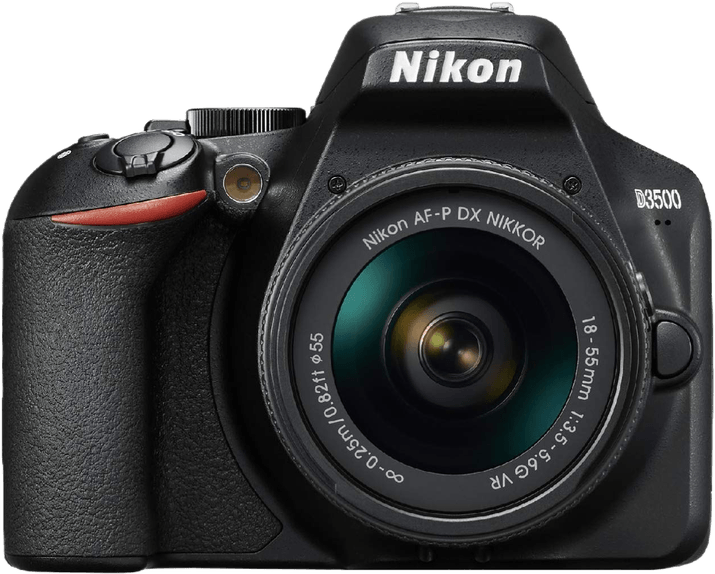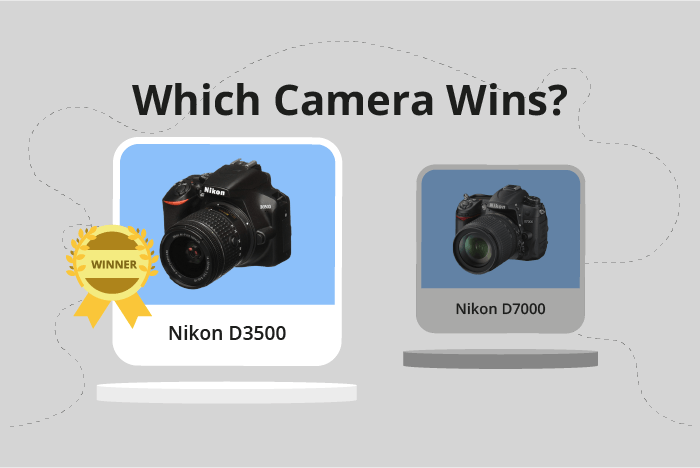Nikon D3500 vs D7000 Comparison
Nikon D3500

Nikon D7000

The Nikon D3500 emerges as the winner with a score of 61/100, while the Nikon D7000 trails behind at 56/100. Both cameras are DSLRs and share some common specifications, such as their camera type. The D3500 wasreleased in 2018 and its dimensions are 124 x 97 x 70mm. It weighs 615g or 1.36lbs, making it lighter than the D7000.
The Nikon D7000, released in 2010, had a launch price of $1200 and dimensions of 132 x 105 x 77mm. It weighs 780g or 1.72lbs. Despite its higher launch price and larger size, the D7000 still falls short in comparison to the D3500. This could be due to its older release year, resulting in outdated technology and features.
Ultimately, the Nikon D3500 proves to be a better option due to its higher score, lower price, and lighter weight. The Nikon D7000, although more expensive, does not offer any significant advantages over the D3500.
Nikon D3500 vs D7000 Overview and Optics
The Nikon D3500 outperforms the Nikon D7000 in optics, scoring 65/100 compared to the D7000’s 55/100. Both cameras share several specifications, including the use of a CMOS sensor, APS-C sensor size, Nikon F lens mount, and the absence of image stabilization. However, there are key differences that contribute to the D3500’s higher score in optics.
The D3500 boasts a higher megapixel count at 24, compared to the D7000’s 16.2 megapixels. This allows the D3500 to capture more detail and produce higher resolution images. Additionally, the D3500 has a more advanced processor, the Expeed 4, while the D7000 uses the older Expeed 2 processor. The improved processor in the D3500 contributes to better image processing and overall performance. The D3500’s superior DXOMARK sensor score of 87, compared to the D7000’s 80, further emphasizes its better image quality.
On the other hand, the D7000 has a faster shooting speed at 6 frames per second (fps), compared to the D3500’s 5 fps. This makes the D7000 more suitable for capturing fast-moving subjects or action scenes. However, this advantage does not outweigh the D3500’s overall better image quality.
Considering the differences in optics, the Nikon D3500 emerges as the better camera in terms of image quality, resolution, and processing. The higher megapixel count, advanced processor, and superior sensor score contribute to its higher optics score. While the D7000 has a faster shooting speed, it is not enough to compensate for its lower image quality. Therefore, the Nikon D3500 proves to be the better choice for those prioritizing optics in their camera selection.
Nikon D3500 vs D7000 Video Performance
The Nikon D7000 narrowly outperforms the Nikon D3500 in video capabilities, with a score of 57/100 compared to the D3500’s 56/100. Both cameras share some common specifications, such as Full HD maximum video resolution and 1920×1080 video dimensions. However, there are key differences that contribute to the D7000’s slight advantage.
The D7000 surpasses the D3500 by offering built-in time-lapse functionality. This feature allows users to create stunning time-lapse videos without the need for additional software or equipment, providing more creative options for videographers. The inclusion of time-lapse functionality in the D7000 contributes to its higher video score.
On the other hand, the D3500 excels in maximum video frame rate, offering 60fps compared to the D7000’s 24fps. This higher frame rate allows for smoother video playback and provides the option for slow-motion effects in post-production. Despite its lower overall video score, the D3500 outshines the D7000 in this particular aspect.
In comparing the video capabilities of the Nikon D3500 and D7000, it is evident that the D7000’s built-in time-lapse functionality gives it an edge over the D3500. However, the D3500’s higher maximum video frame rate should not be overlooked, as it provides smoother video playback and slow-motion possibilities. Therefore, the choice between these two cameras depends on the specific video needs and preferences of the user.
Nikon D3500 vs D7000 Features and Benefits
The Nikon D3500 and Nikon D7000 both have a feature score of 54/100. These cameras share several specifications, including a 3-inch screen size and the absence of a touchscreen and flip screen. Neither camera has GPS functionality.
The Nikon D3500 surpasses the D7000 in screen resolution, offering 921,600 dots compared to the D7000’s 921,000 dots. Additionally, the D3500 has Bluetooth connectivity, which the D7000 lacks. This allows for easier transfer of photos and remote control of the camera through a smartphone.
On the other hand, the Nikon D7000 boasts Wi-Fi capability, which the D3500 does not have. This feature enables wireless photo transfer and remote control of the camera through a compatible device. The absence of Wi-Fi in the D3500 may be a drawback for some users who prioritize wireless connectivity.
In terms of features, the Nikon D3500 and D7000 are closely matched, with each camera having its advantages. The D3500’s higher screen resolution and Bluetooth connectivity make it a strong contender, while the D7000’s Wi-Fi functionality offers its own set of benefits. Ultimately, the choice between these cameras will depend on the individual user’s preferences and priorities.
Nikon D3500 vs D7000 Storage and Battery
The D3500 excels in battery life, offering 1550 shots per charge with its EN-EL14a battery. The D7000, on the other hand, provides 1050 shots per charge using the EN-EL15 battery. This difference gives the D3500 a clear advantage for extended shooting sessions.
While the D7000 lags behind in battery life, it does offer a distinct advantage in storage with its dual memory card slots. Neither camera has USB charging capabilities. Both cameras share similar storage specifications, and the D7000’s battery life falls short compared to the D3500.
Considering the storage and battery aspects, the Nikon D3500 proves to be the better option with its longer battery life, while the D7000 does not offer any unique benefits in this category.
Nikon D3500 vs D7000 – Our Verdict
Are you still undecided about which camera is right for you? Have a look at these popular comparisons that feature the Nikon D3500 or the Nikon D7000:

